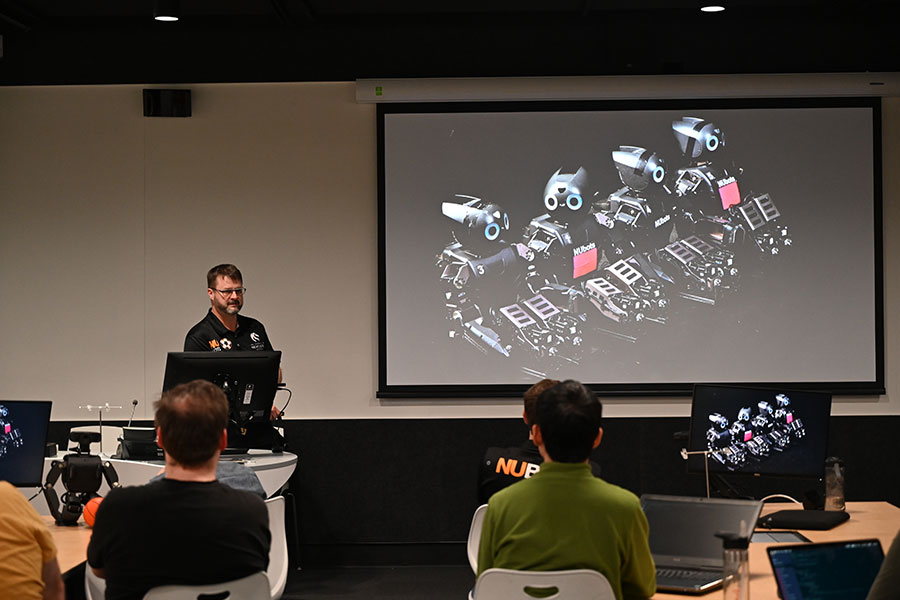Researcher Highlights
Computers that ‘think’ like humans
By studying how the human mind works, Professor Stephan Chalup and his research team are developing clever machines that mimic the way we learn.

Professor Stephan Chalup and his research team at the University of Newcastle are contributing to an entirely new generation of machine learning. Using artificial neural networks—a machine learning tool inspired by the human brain—they have developed a suite of robots and computer systems that replicate the way human minds learn, process information and complete tasks.
“In my lab, we use what is known about how the mind works—how the neurons in the brain interact—to develop computer programs that allow machines to analyse images, sound recordings or process other data.”
Our human minds are constantly scanning the environment, processing huge amounts of information and deciding how to respond. For example, what happens when we walk into a café with a friend and have to decide where to sit? Our senses immediately kick in, studying the environment and available tables, what we know about our friend and about our own preferences. Our brain processes all the information we need to make a decision that may seem trivial to us but is very hard to implement realistically on a companion robot.
“By investigating these abstract underlying principles of the human neural systems, we can create artificial neural network simulations that can perform pattern analysis and control tasks.”
Stephan’s work has revealed new possibilities across the fields of artificial intelligence, machine learning, pattern recognition, data analysis, computer vision and control. It also presents exciting opportunities for industries. From solving complex challenges such as new methods in the minerals and mining industry, transport safety, through to deep data analysis needed for medical breakthroughs, the applications of Stephan’s work are extensive.
“After all these years, it is still amazing to see what artificial neural networks can do.”
A new generation of smart robots
Stephan and his team have recently developed new artificial neural networks for robots that allow them to detect objects more accurately and with higher frame rates than ever thought possible. His robots can perform complex tasks, and Stephan enjoys putting them to the test—and showing off their abilities.
“Our robot soccer team, the NUbots, has won two world titles. If you think about it, soccer is a highly complex task for a robot to perform. Our team of researchers and students have travelled to many cities around the world to participate in RoboCup, and our work has inspired an increasing number of young people to become involved in robotics.”
“It is fun to work in the lab with my team, students and colleagues. It’s satisfying work, and we’re proud to contribute to Australia’s international reputation in this field.”
The students that Stephan mentors are always excited to be involved in new projects happening at the lab. Their hands-on experience also stands them in good stead for a successful career, developing and testing the next generation of robotics and computer technology.
“Our robotics lab has some of the best computers and robots, as well as a team of very talented and motivated students. Alumni from our lab now work in some of the most fascinating jobs around the world.”
Practical industry solutions
Along with tearing up the soccer field, Stephan’s computer systems are also helping to solve complex industry challenges across the Hunter and worldwide. Stephan’s interdisciplinary research has led to advancements in medical imaging, architectural design analysis, material science and transport safety—just to name a few.
“We have used our experience with artificial neural networks and deep learning to improve train transport safety for local industry. Our machines can detect objects and dangerous situations along the track faster and with higher precision than previously thought possible.”
“Other areas of our work could be used in medical imaging to improve health. We have been implementing machine learning methods on robots that could be useful, for example, within the independent living domain as care robots.”
To achieve the best outcomes, Stephan’s work is often conducted in partnership with other disciplinary teams at the University of Newcastle. This interdisciplinary approach to research allows his work to be applied in novel ways.
“I enjoy interdisciplinary research and new challenges. For example, over about eight years I collaborated with a colleague in architecture on two Australian Research Council (ARC) Discovery Projects. Some of the work we did inspired researchers on the other side of the globe to do related work based on our projects.”
Understanding high-dimensional data
Stephan’s most recent work has included studies on high-dimensional data. Before computer systems can solve a problem, they must sort through and categorise an enormous amount of data with extensive numbers of variables. Traditionally, mathematical techniques have enabled machines to predict the future based on past data. Stephan and his team have posed a different idea.
“We found that some of our new techniques based on neural network principles work more robustly and more efficiently in applications than traditional deterministic methods.”
“In some recent work we learned how employ neural networks and algebraic topology to analyse and better understand 3D or high-dimensional data.”
The power of the human mind
Stephan’s work is built on an in-depth understanding of the human brain and how it works as a complex and powerful processing system. Yet Stephan explains that our biological neural networks are still “grossly underestimated”.
Through his work, Stephan aims to explain how human thoughts are represented and processed in our brains—and provide tantalising insights into what makes us tick.
“We want to provide humans with a better understanding of their own abilities and limitations, not so that artificial intelligence becomes more powerful and gains control, but so that us humans can deal with the world in a better way.”
The University of Newcastle acknowledges the traditional custodians of the lands within our footprint areas: Awabakal, Darkinjung, Biripai, Worimi, Wonnarua, and Eora Nations. We also pay respect to the wisdom of our Elders past and present.
